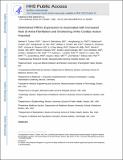Diminished PRRX1 Expression Is Associated With Increased Risk of Atrial Fibrillation and Shortening of the Cardiac Action Potential
Author(s)
Imakaev, Maxim; Mirny, Leonid
DownloadAccepted version (1.318Mb)
Terms of use
Metadata
Show full item recordAbstract
Atrial fibrillation (AF) affects over 33 million individuals worldwide. Genome-wide association studies have identified at least 30 AF loci, but the mechanisms through which individual variants lead to altered disease risk have remained unclear for the majority of these loci. At the 1q24 locus, we hypothesized that the transcription factor PRRX1 could be a strong candidate gene as it is expressed in the pulmonary veins, a source of AF in many individuals. We sought to identify the molecular mechanism, whereby variation at 1q24 may lead to AF susceptibility. Methods and Results - We sequenced a ≈158 kb region encompassing PRRX1 in 962 individuals with and without AF. We identified a broad region of association with AF at the 1q24 locus. Using in silico prediction and functional validation, we identified an enhancer that interacts with the promoter of PRRX1 in cells of cardiac lineage. Within this enhancer, we identified a single-nucleotide polymorphism, rs577676, which alters enhancer activity in a mouse atrial cell line and in embryonic zebrafish and differentially regulates PRRX1 expression in human left atria. We found that suppression of PRRX1 in human embryonic stem cell-derived cardiomyocytes and embryonic zebrafish resulted in shortening of the atrial action potential duration, a hallmark of AF. Conclusions - We have identified a functional genetic variant that alters PRRX1 expression, ultimately resulting in electrophysiological alterations in atrial myocytes that may promote AF. ©2017
Date issued
2017-10Department
Massachusetts Institute of Technology. Institute for Medical Engineering & ScienceJournal
Circulation: Cardiovascular Genetics
Publisher
Ovid Technologies (Wolters Kluwer Health)
Citation
Tucker, Nathan R., et al., "Diminished PRRX1 Expression Is Associated With Increased Risk of Atrial Fibrillation and Shortening of the Cardiac Action Potential." Circulation: Cardiovascular Genetics 10, 5 (Oct. 2017): no. e001902 doi 10.1161/CIRCGENETICS.117.001902 ©2017 Author(s)
Version: Author's final manuscript
ISSN
1942-3268
1942-325X